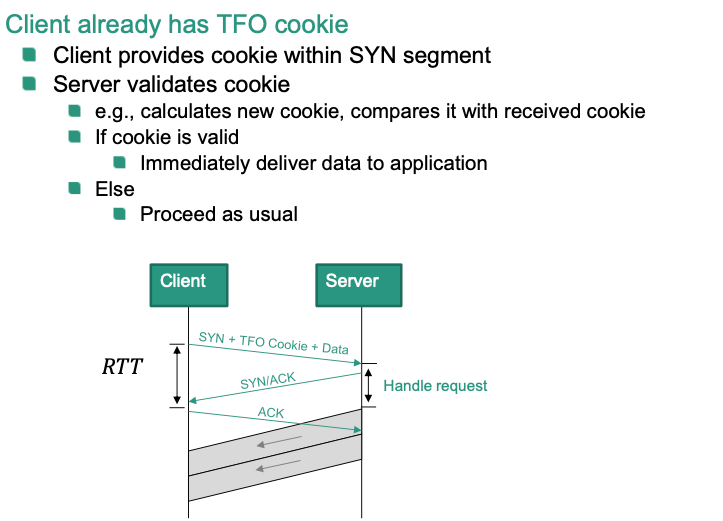TCP Evolution

TCP Extensions
TCP Options: Basics
TCP Header
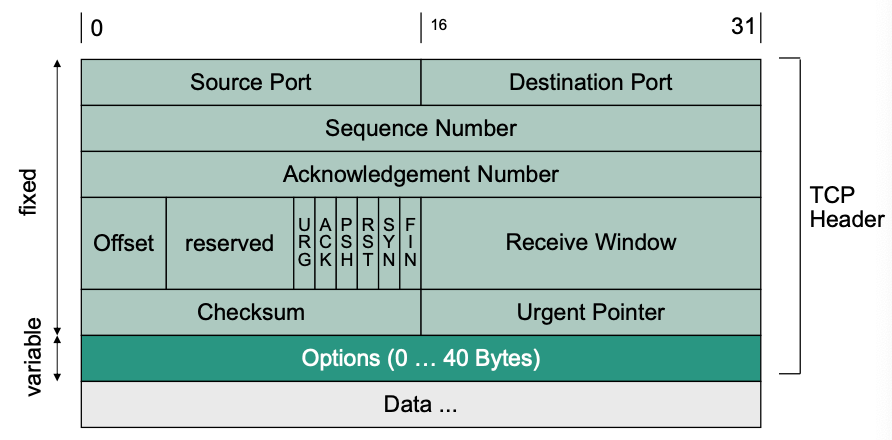
TCP Options
🎯 Goal: Flexibility for new developments
TCP header field
- Each option is coded in TLV format (Type-Length-Value)
- Has variable but limited length
- number of options is limited (max. 40 bytes)
- TCP header length at most 60 bytes in total (incl. options)
TLV format

Multiple of 32 bit words (If not padding is needed)
Type
Time stamps
Maximum segment size
Multipath TCP
TCP fast open
…
Length: Length of option
Value: Option data
Option Selective Acknowledgements
TCP uses cumulative acknowledgements
👍 Pro: Very robust against loss of ACK segments
👎 Cons: Inefficient loss recovery
Sender can only learn about a single lost segment per RTT
Consequently
Fast retransmit/fast recovery can only recover one lost segment
per RTT
Multiple losses often lead to retransmission timeouts and head-of-line blocking
Improvement: selective acknowledgements (SACK)
- Also acknowledge “out-of-order” data
- Implemented as TCP option
💡 Idea: Separately acknowledge continuous blocks of out-of-order data
Usage of SACK option negotiated during connection establishment

SACK option format
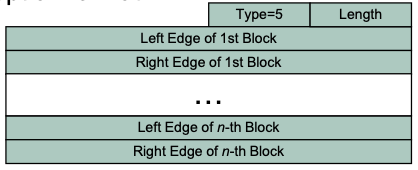
- Typically, only 2-4 blocks can be “SACKed” in one segment
Case
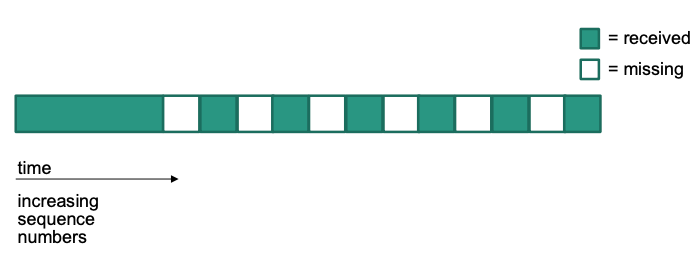
Handling:
- Use first entry of SACK option to report new information
- Use subsequent entries of SACK option for redundancy Used for redundancy,
if prior ACKs were lost
Should repeat most recently sent first blocks
Different alternatives
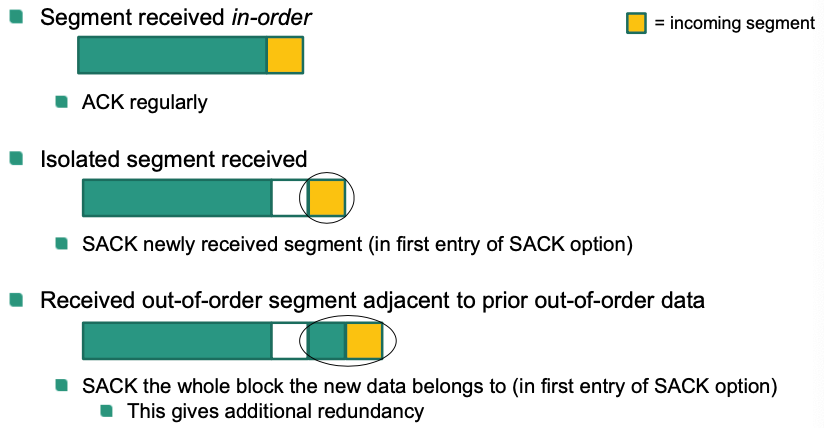
Example
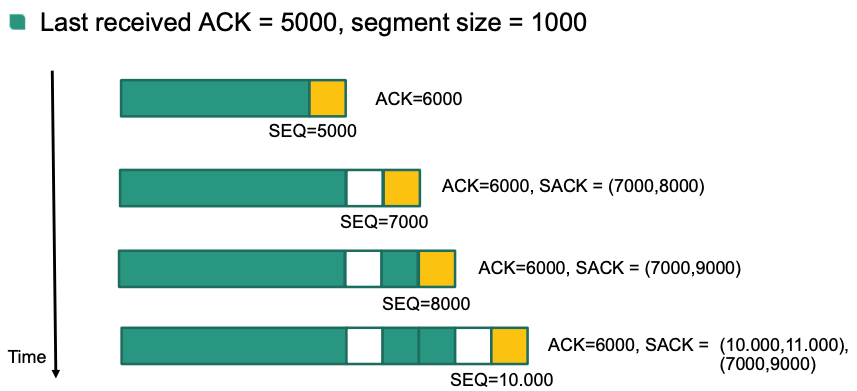
Option Window Scaling
- Header field receive window remains unchanged (16 bit)
- Scaling factor can be changed
- E.g., measure window size in 32 bit words instead of bytes
- Option is negotiated during connection establishment
- Within SYN and SYN/ACK segments
- Scaling factor remains unchanged during lifetime of a TCP connection
Extension SYN Cookies
Multipath TCP (MPTCP)
Motivation
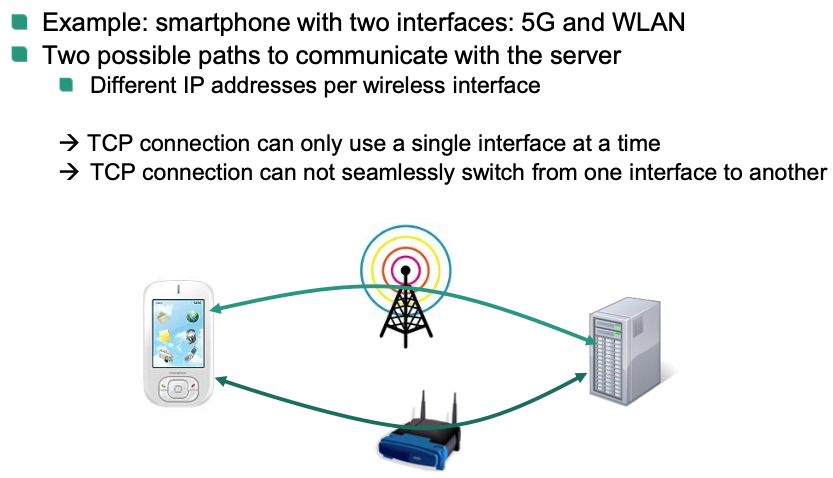
🎯 Goal: Extension of TCP for parallel usage of multiple paths within a single TCP connection
- Improves reliability
- Increases performance
Important requirements
- Application compatibility
- Network compatibility
Challenges
- Middleboxes
Connection vs. Subflow
- MPTCP connection
- Communication relation between sender and receiver
- Consists of one or multiple MPTCP subflows
- MPTCP subflow
- Flow of TCP segments operating over an individual path
- Started and terminated like a „regular“ TCP connection
Started with 3-way handshake
Closed with FIN or RST
- Can be dynamically added and removed to/from an MPTCP connection
Embedding into Protocol Stack
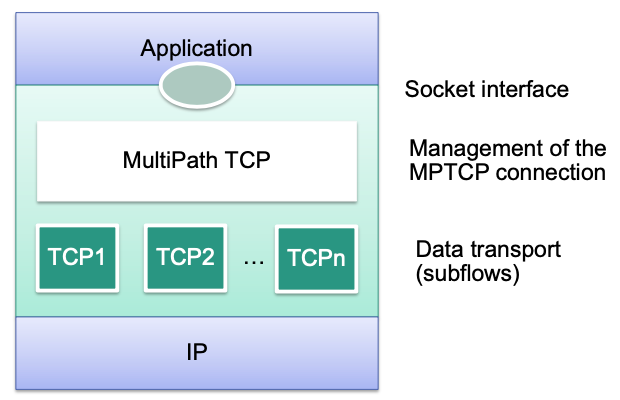
Connection Establishment
3-way handshake of TCP
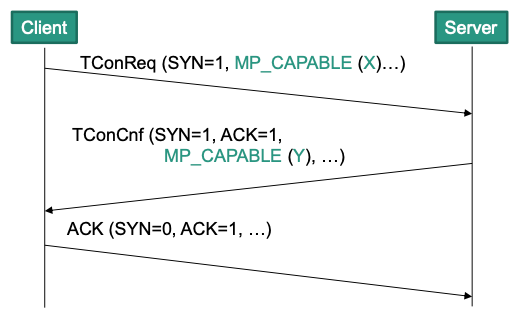
TCP option MP_CAPABLE
X,Y: token for client and server- Identification for subsequent addition/removal of subflows
Adding a Subflow
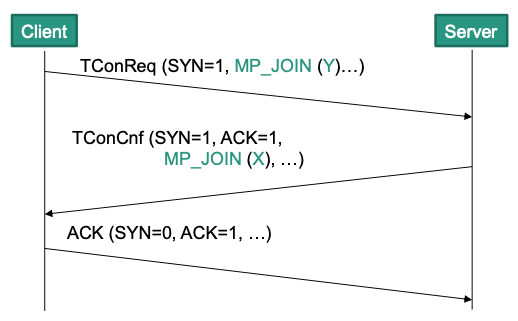
TCP option MP_JOIN
- 3-way handshake of TCP
- Use tokens exchanged during MPTCP connection establishment
Sequence Numbers
Each MPTCP segment carries two sequence numbers
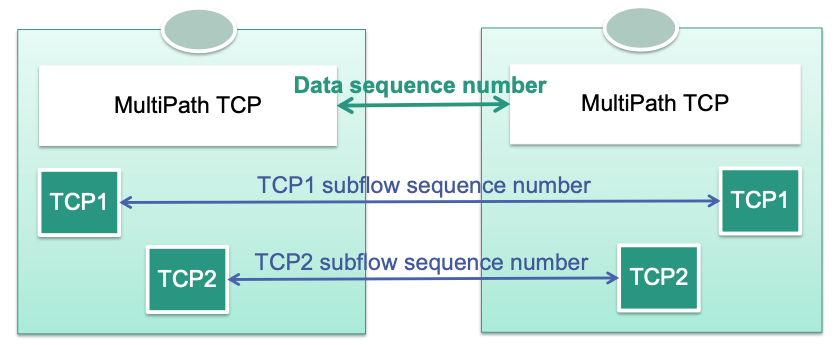
- Data sequence number for overall MPTCP connection
- Subflow sequence number for individual flow
- Each subflow has coherent sequence numbers without „holes“
Congestion Control
🎯 Goals of MPTCP
Improve throughput
Multipath flow should perform at least as well as a single path congestion control would on the best available path
Do not harm
Multipath flow should not take up more capacity from any of the resources shared than if it were a single flow
Balance congestion
A multipath flow should have as much traffic as possible off its most congested paths
Congestion Control algorithm only applies to increase phase of congestion avoidance
- Unchanged: slow start, fast retransmit, fast recovery and multiplicative decrease
Different congestion windows
- per subflow
- per MPTCP connection (multipath flow)
Assumption: Congestion window maintained in bytes
Basic approach: Couple congestion control of different subflows
Linked increase (congestion avoidance)
For each ACK received on subflow , increase by
(any multipath subflow cannot be more aggressive than a TCP flow in the same circumstances (do not harm))
- : Describes aggressiveness of multipath flow
TCP in Networks with High BDP
Scalability Issues
It can take very long until the available data rate is fully utilized
Cause
Very conservative behavior of congestion avoidance
- Congestion window grows by one MSS per RTT
- Slow window growth in congestion avoidance causes low average data rate
➡️ NOT efficient in networks with high bandwidth-delay products
Require faster increase of the congestion window in congestion avoidance
Faster Increase of Congestion Window
- 🎯 Goals
High resource utilization in networks with high bandwidth delay product
Quick reactions to changes of the situation within the network
Fairness with respect to other TCP variants
- Different types of fairness
- intra protocol fairness
- All senders use same TCP variant
- Goal: All flows should achieve same data rate
- With new TCP variants: inter protocol fairness
- Furthermore: RTT fairness
- Fairness among TCP flows with different RTTs
- intra protocol fairness
CUBIC TCP
🎯 Goals
Provide simple algorithm for networks with high bandwidth-delay product
TCP-friendly
Behaves like standard TCP (i.e., TCP Reno) in networks with short RTTs and small bandwidth
Congestion avoidance
Applies cubic function instead of linear window increase
Performance should not be worse than TCP Reno
In comparison to TCP Reno
- Better RTT fairness (Window growth independent of RTT)
- Better scalability to high data rates
Currently default congestion control in all major operating systems
Congestion Window Increase
Independent from RTT
Use of actual time that has passed since last congestion incident. I.e. Window growth depends on time between consecutive congestion events
Apply cubic function
- : predefined constant that determines aggressiveness of increase
- : congestion window size at latest congestion incident
- : time period that it takes to increase current window to (in case of no further congestions)
- : multiplicative decrease of congestion window
- for TCP-Reno
- for CUBIC TCP
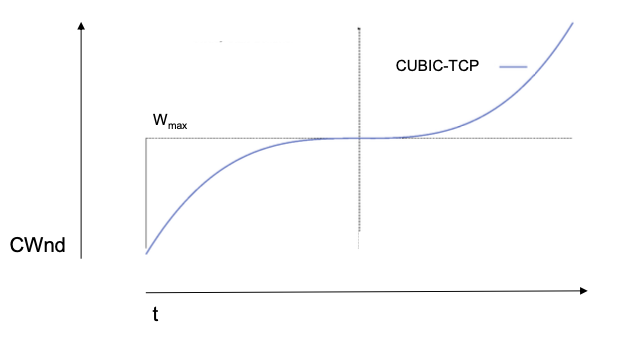
Congestion Window over Time
Example
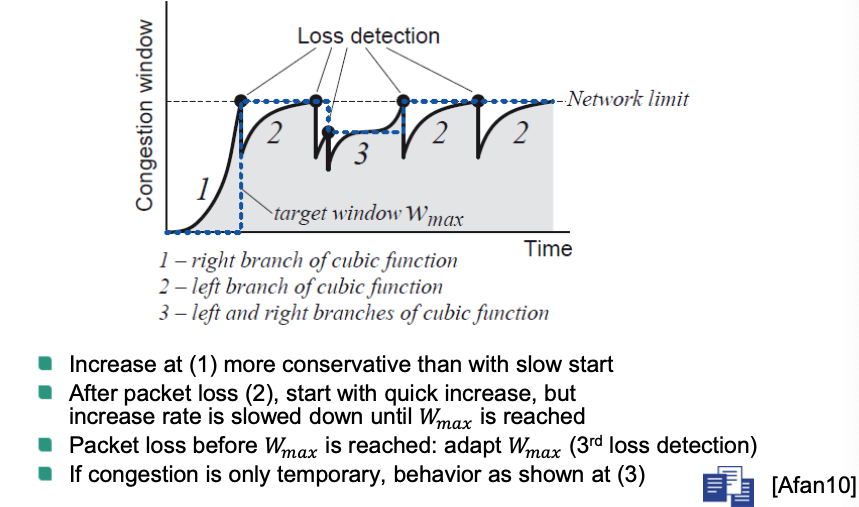
Three CUBIC Modes
TCP-friendly region
Ensures that CUBIC achieves at least same data rate as standard TCP in networks with small RTT
Observation: in networks with small RTTs, Cubic ́s congestion window grows slower than with TCP Reno
Approach: “emulation” of TCP Reno (which uses AIMD)
: additive increase factor
: multiplicative decrease factor
TCP Reno uses
TCP-fair increment
Achieves same as
Average data rate of AIMD
- : loss rate
Window size of emulated TCP at time
Recall window size of TCP cubic
Rule
- , then is set to each time an ACK is received
- otherwise, is set to each time an ACK is received
Concave region: and not in TCP-friendly region
- For each received ACK
Convex region: and not in TCP-friendly region
- is increased very carefully
- searching for new 𝑊𝑚𝑎𝑥
TCP and Response Time
Basic Issue
Response time
Time between initiation of a TCP connection and receipt of the requested data
Important components

Handshake of TCP connection establishment
Slow start
Transmission of the object
Macroscopic Model
Response time without applying congestion control
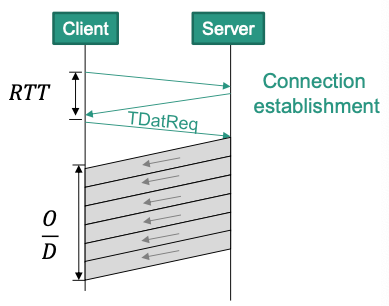
After 1st RTT: Client sends object request
After 2nd RTT
Client begins to receive object data
Receiver needs
lower bound:
( With small objects, response time dominated by s)
Used Variables
- : round trip time [Seconds]
- : maximum segment size [bit]
- : Size of congestion window [MSS], given as multiples of MSS
- : Size of object that has to be transferred [bit]
- : Data rate [bit/s]
Observation
s have significant influence on response time
On connection establishment: 2 𝑠 until reception of object begins
During object transmission
- Small windows create pauses: waiting for ACKs
Majority of TCP connections in the Web has short lifetime
Slow start has significant impact on response time
🎯 Goals
- Avoid „empty“ RTTs without data transport
- Reduce RTTs needed for slow start
Bigger Initial Congestion Window
💡 Idea: Increase initial congestion window (IW)
- at least 10 segments, thus, about 15 Kbytes
TCP Fast Open
🎯 Goal: Reduce delays that precede the transmission of an object
TCP Cookie
Goal
Avoid DoS attacks
Disallow sending data within first SYN segment of first connection establishment to a server
Establish cookie for subsequent connections
Use cookie avoid state keeping at server
Basic steps
Client requests TFO cookie from server
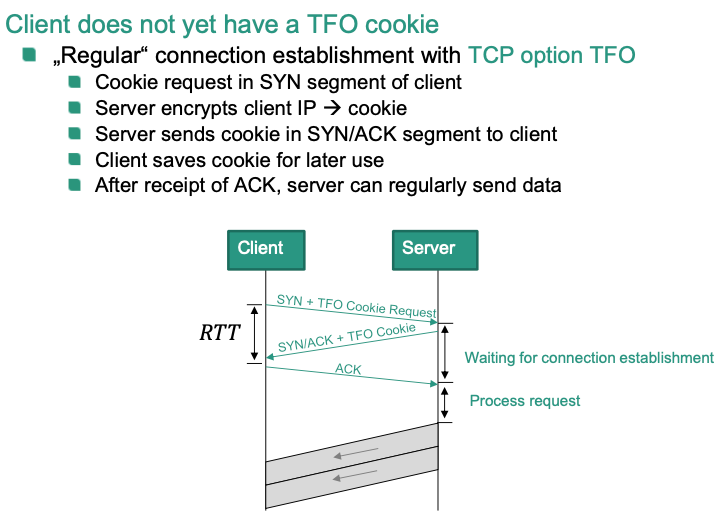
Client uses TFO cookies in subsequent TCP connections
